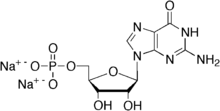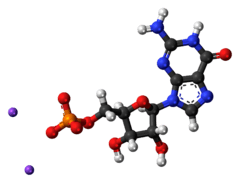Disodium guanylate
 | |
 | |
| Names | |
|---|---|
| IUPAC name
disodium [(2R,3S,4R,5R)-5-(2-amino-6-oxo-3H-purin-9-yl)-3,4-dihydroxy-2-tetrahydrofuranyl]methyl phosphate | |
| Other names
sodium 5'-guanylate disodium 5'-guanylate | |
| Identifiers | |
| 5550-12-9 | |
| ChemSpider | 20407 |
| Jmol interactive 3D | Image |
| PubChem | 21712 |
| |
| Properties | |
| C10H12N5Na2O8P | |
| Molar mass | 407.19 g·mol−1 |
| Except where otherwise noted, data are given for materials in their standard state (at 25 °C [77 °F], 100 kPa). | |
| | |
| Infobox references | |
Disodium guanylate, also known as sodium 5'-guanylate and disodium 5'-guanylate, is a natural sodium salt of the flavor enhancing DNA nucleotide guanosine monophosphate (GMP). Disodium guanylate is a food additive with the E number E627.[2] It is commonly used in conjunction with glutamic acid (monosodium glutamate, MSG).
As it is a fairly expensive additive, it is not used independently of glutamic acid; if disodium guanylate is present in a list of ingredients but MSG does not appear to be, it is likely that glutamic acid is provided as part of another ingredient such as a processed soy protein complex. It is often added to foods in conjunction with disodium inosinate; the combination is known as disodium 5'-ribonucleotides.
Disodium guanylate is produced from dried seaweed and is often added to instant noodles, potato chips and other snacks, savory rice, tinned vegetables, cured meats, and packaged soup.
Nutritional information
Disodium guanylate is not safe for babies under twelve weeks, and should generally be avoided by asthmatics and people with gout, as guanylates are metabolized to purines. However, the typical amounts found in food are generally too low to produce significant side effects.[2] Since it is often produced from fish,[2] vegans and vegetarians may wish to avoid it unless the product is specifically labeled as vegan or vegetarian. Such labels require the use of non-animal derived sources, such as seaweed or yeast.